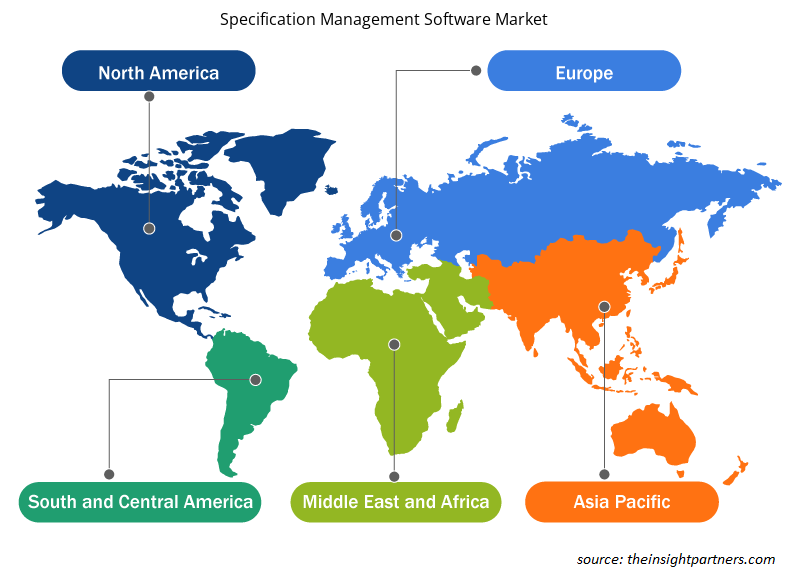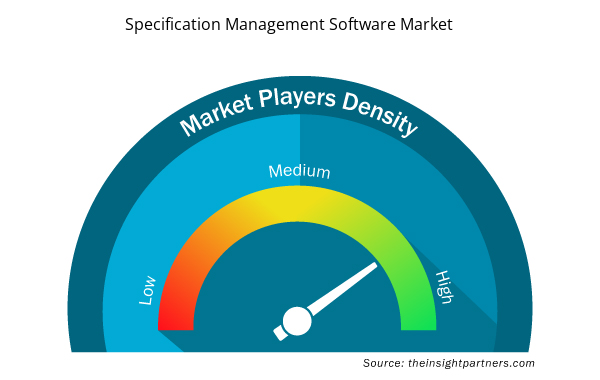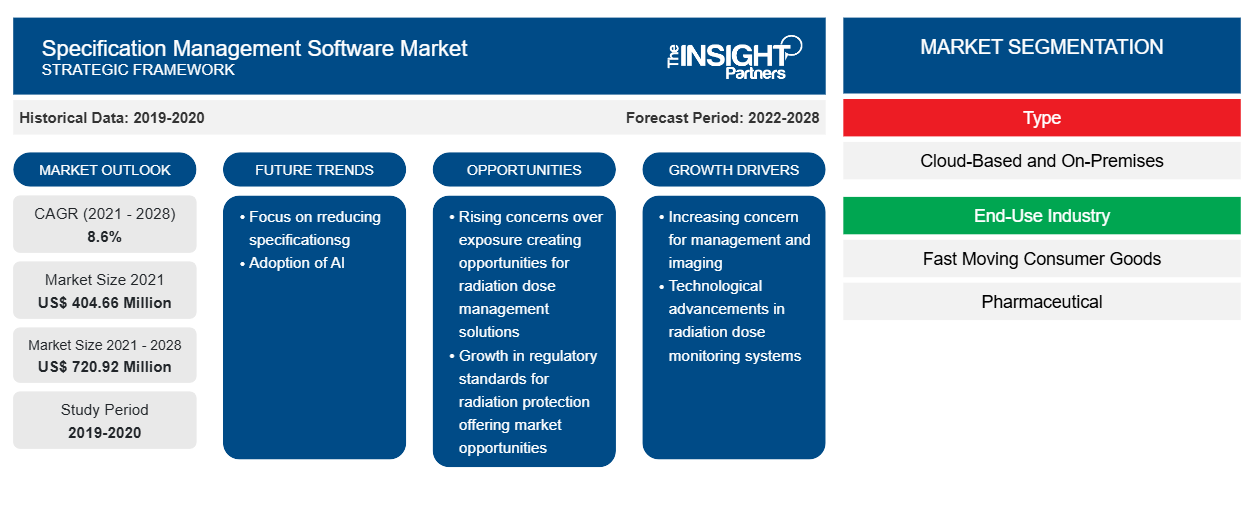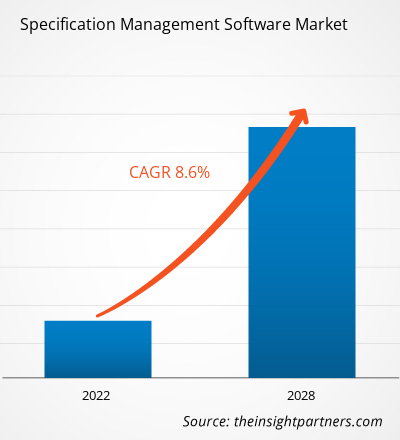Si prevede che il mercato del software di gestione delle specifiche crescerà da 404,66 milioni di dollari nel 2021 a 720,92 milioni di dollari entro il 2028; si stima che crescerà a un CAGR dell'8,6% nel periodo 2021-2028.
I prodotti farmaceutici vengono fabbricati combinando diversi tipi di sostanze chimiche o biologiche. Il processo di fabbricazione comprende una serie di operazioni unitarie, tra cui granulazione, riempimento, miscelazione, macinazione, pressatura di compresse e rivestimento. I produttori devono attenersi a normative specifiche e seguire le linee guida appropriate per mantenere la quantità accurata di sostanze chimiche e sostenerne la qualità. Le apparecchiature coinvolte nella produzione farmaceutica devono essere gestite e sottoposte a manutenzione secondo le buone pratiche di fabbricazione ( GMP ). Con il continuo aumento della domanda di medicinali/farmaci in tutto il mondo, le aziende farmaceutiche stanno investendo in modo significativo nell'implementazione di varie soluzioni IT in diverse operazioni. Ad esempio, il software di gestione delle specifiche viene adottato per la specifica accurata e precisa delle sostanze chimiche utilizzate nella produzione farmaceutica; ciò aiuta le aziende farmaceutiche a garantire la qualità e la conformità normativa lungo l'intera catena del valore del settore.
Catene di fornitura complesse, normative rigide e problemi di integrità dei dati influiscono sulle strategie e sui processi di qualità nel settore farmaceutico. La FDA e altre autorità equivalenti si concentrano rigorosamente sulla conformità normativa da parte delle aziende farmaceutiche, garantendo così il mantenimento degli standard di qualità nell'intero settore farmaceutico globale. I dati del software di gestione delle specifiche consentono agli utenti di mantenere metriche coerenti, calcoli dei rischi e altre analisi di tendenza. La funzione del software di gestione delle specifiche comprende la gestione delle materie prime, la gestione delle formule e degli ingredienti, la gestione degli imballaggi, la gestione dei documenti e la gestione della qualità. Ad esempio, Pilgrim Quality Solutions offre soluzioni SmartSolve Pharmaceutical QMS che gestiscono in modo preciso e accurato la gestione dei documenti, la gestione fuori specifica, la gestione dei richiami, la gestione della qualità dei fornitori e così via.
Personalizza questo report in base alle tue esigenze
Riceverai la personalizzazione gratuita di qualsiasi report, comprese parti di questo report, o analisi a livello nazionale, pacchetto dati Excel, oltre a usufruire di grandi offerte e sconti per start-up e università
- Scopri le principali tendenze di mercato in questo rapporto.Questo campione GRATUITO includerà analisi di dati che spaziano dalle tendenze di mercato alle stime e alle previsioni.
Impatto della pandemia di COVID-19 sul mercato del software di gestione delle specifiche in Nord America
La pandemia di COVID-19 ha avuto gravi ripercussioni su molti settori industriali nei paesi del Nord America, come Stati Uniti, Canada e Messico.L'aumento senza precedenti del numero di casi di COVID-19 negli Stati Uniti e la successiva imposizione di varie restrizioni per combattere la diffusione del virus nei primi due trimestri del 2020 hanno ostacolato le prestazioni di varie aziende. Gli investimenti tecnologici hanno subito un calo considerevole nel 2020. Tuttavia, la pandemia ha avuto un impatto sul modo in cui le aziende lavorano e le ha incoraggiate a utilizzare piattaforme digitali per svolgere operazioni aziendali da sedi remote. Il Nord America è in prima linea nell'accettare e sviluppare tecnologie all'avanguardia grazie a politiche governative favorevoli per promuovere l'innovazione e rafforzare le capacità infrastrutturali. Poiché gli Stati Uniti hanno un'elevata densità di attori del mercato del software di gestione delle specifiche , l'epidemia ha gravemente influenzato la produzione di ciascuno, soprattutto all'inizio del 2020, quando vi erano severe restrizioni sui trasporti.
Approfondimenti sul mercato del software di gestione delle specifiche
Il fiorente settore FMCG alimenta la crescita del mercato del software di gestione delle specifiche
Il settore globale dei beni di consumo in rapida evoluzione ( FMCG ) è sotto pressione continua per il lancio di nuovi prodotti. Tutti i lanci di prodotti sperimentano un ciclo di sviluppo del prodotto per fornire ogni progetto in un lasso di tempo specificato. Il settore FMCG sta costantemente vivendo una crescita sana, che è principalmente attribuita all'adozione di una vendita al dettaglio intelligente. Il concetto di vendita al dettaglio intelligente obbliga i rivenditori a concentrarsi costantemente sul soddisfacimento delle esigenze dei consumatori in continua evoluzione e sulla fornitura di un'esperienza di acquisto migliorata e conveniente ai consumatori. Nel settore dei beni di consumo, il software di gestione delle specifiche viene distribuito in processi quali la gestione delle materie prime, l'imballaggio e la documentazione dei dettagli del prodotto. L'imballaggio ha la massima importanza in quanto è il primo aspetto che i consumatori osservano e toccano. PackIQ , ORBIS Corporation, TODAY IT, GEFCO e Amatech sono tra i fornitori di strumenti di gestione dell'imballaggio per il settore della vendita al dettaglio e dei beni di consumo.
Inoltre, la qualità del prodotto continua a essere la preoccupazione principale per i consumatori. Pertanto, le aziende, in particolare nel settore dei beni di consumo, si concentrano costantemente sulla fornitura di prodotti di qualità standard in modo tempestivo e senza problemi. La conseguente necessità di aggiornare i processi, i servizi e i risultati richiede un intervento tecnologico, che sta stimolando l'adozione di software di gestione delle specifiche. Di conseguenza, l'adozione di software di gestione delle specifiche per la gestione dei documenti, la gestione degli imballaggi e la gestione delle illustrazioni è in aumento nel settore FMCG, il che consente ulteriormente ai rivenditori di raggiungere l'eccellenza del cliente.
Approfondimenti di mercato basati sul tipo
In base al tipo, il mercato del software di gestione delle specifiche è diviso in cloud-based e on-premise. Nel 2020, il segmento basato su cloud ha rappresentato una quota maggiore del mercato.
Approfondimenti di mercato basati sulle applicazioni
Basato su
applicazione
, il mercato del software di gestione delle specifiche è segmentato in gestione delle materie prime, gestione delle formule e degli ingredienti, gestione degli imballaggi, gestione dei documenti e altre applicazioni. Nel 2020, il segmento di gestione degli imballaggi ha rappresentato la quota di mercato maggiore.
I player che operano nel mercato del software di gestione delle specifiche adottano strategie quali fusioni, acquisizioni e iniziative di mercato per mantenere le loro posizioni nel mercato. Di seguito sono elencati alcuni sviluppi dei player chiave:
- Nel 2021, Emerson ha annunciato
suo
investimento azionario in Fluxaper il suo
Software di gestione dei processi e della conoscenza (PKMTM)Quello
gestisce in modo fluido le specifiche di prodotto e di processo durante l'intero ciclo di vita dello sviluppo del prodotto. - A maggio 2021, Specright è diventata membro Silver del GS1 US Solution Partner Program. Questa designazione indica l'impegno di Specright nell'offrire soluzioni e servizi che consentano un'implementazione efficiente, rapida e accurata degli standard GS1.
Approfondimenti regionali sul mercato del software di gestione delle specifiche
Le tendenze regionali e i fattori che influenzano il mercato del software di gestione delle specifiche durante il periodo di previsione sono stati ampiamente spiegati dagli analisti di Insight Partners. Questa sezione discute anche i segmenti e la geografia del mercato del software di gestione delle specifiche in Nord America, Europa, Asia Pacifico, Medio Oriente e Africa e America meridionale e centrale.

- Ottieni i dati specifici regionali per il mercato del software di gestione delle specifiche
Ambito del rapporto di mercato sul software di gestione delle specifiche
| Attributo del report | Dettagli |
|---|---|
| Dimensioni del mercato nel 2021 | 404,66 milioni di dollari USA |
| Dimensioni del mercato entro il 2028 | 720,92 milioni di dollari USA |
| CAGR globale (2021 - 2028) | 8,6% |
| Dati storici | 2019-2020 |
| Periodo di previsione | 2022-2028 |
| Segmenti coperti | Per tipo
|
| Regioni e Paesi coperti | America del Nord
|
| Leader di mercato e profili aziendali chiave |
|
Densità dei player del mercato del software di gestione delle specifiche: comprendere il suo impatto sulle dinamiche aziendali
Il mercato del software di gestione delle specifiche sta crescendo rapidamente, spinto dalla crescente domanda degli utenti finali dovuta a fattori quali l'evoluzione delle preferenze dei consumatori, i progressi tecnologici e una maggiore consapevolezza dei vantaggi del prodotto. Con l'aumento della domanda, le aziende stanno ampliando le loro offerte, innovando per soddisfare le esigenze dei consumatori e capitalizzando sulle tendenze emergenti, il che alimenta ulteriormente la crescita del mercato.
La densità degli operatori di mercato si riferisce alla distribuzione di aziende o società che operano in un particolare mercato o settore. Indica quanti concorrenti (operatori di mercato) sono presenti in un dato spazio di mercato in relazione alle sue dimensioni o al valore di mercato totale.
Le principali aziende che operano nel mercato del software di gestione delle specifiche sono:
- Accompa, Inc.
- Azienda Emerson Electric
- ASSICURAZIONE
- Esco
- Isolosità
Disclaimer : le aziende elencate sopra non sono classificate secondo un ordine particolare.

- Ottieni la panoramica dei principali attori del mercato dei software di gestione delle specifiche
Il mercato globale del software di gestione delle specifiche è stato segmentato come indicato di seguito:
Per tipo
- Basato su cloud
- In sede
Per settore di utilizzo finale
- Beni di largo consumo (FMCG)
- Farmaceutico
- Altri
Per applicazione
- Gestione delle materie prime
- Gestione di formule e ingredienti
- Gestione degli imballaggi
- Gestione dei documenti
- Altre applicazioni
Per Geografia
- America del Nord
- NOI
- Canada
- Messico
- Europa
- Francia
- Germania
- Italia
- Regno Unito
- Russia
- Resto d'Europa
- Asia Pacifico (APAC)
- Cina
- India
- Corea del Sud
- Giappone
- Australia
- Resto dell'APAC
- Medio Oriente e Africa (MEA)
- Sudafrica
- Arabia Saudita
- Emirati Arabi Uniti
- Resto del MEA
- America del Sud (SAM)
- Brasile
- Argentina
- Resto del SAM
Profili aziendali
- Accompa, Inc.
- Esko-Graphics BV.
- Azienda Emerson Electric
- Lascom
- Siemens AG
- SAP SE
- DocXellente
- Isolosità
- Gruppo PiLog
- QADEX
- DIRITTO DELLO SPETTRO
- Analisi storica (2 anni), anno base, previsione (7 anni) con CAGR
- Analisi PEST e SWOT
- Valore/volume delle dimensioni del mercato - Globale, regionale, nazionale
- Industria e panorama competitivo
- Set di dati Excel


- Workwear Market
- Blood Collection Devices Market
- Architecture Software Market
- Intraoperative Neuromonitoring Market
- Sandwich Panel Market
- Emergency Department Information System (EDIS) Market
- Sodium Bicarbonate Market
- Medical Devices Market
- Nitrogenous Fertilizer Market
- Small Internal Combustion Engine Market

Report Coverage
Revenue forecast, Company Analysis, Industry landscape, Growth factors, and Trends

Segment Covered
This text is related
to segments covered.

Regional Scope
North America, Europe, Asia Pacific, Middle East & Africa, South & Central America

Country Scope
This text is related
to country scope.
Domande frequenti
The trend of using advanced technologies is prevailing across the world. Due to rising business activities in pharmaceutical, food & beverages, consumer goods, and manufacturing industries globally, the adoption of advanced specification management tools is ready to capture the attention of massive end users. Furthermore, it has been observed that more than 75% of enterprises are planning to foster their digital transformation to have business recovery out of 2020. The enterprises are looking forward to adopting collaborative and cost-effective solutions to achieve their pre-determined digital goals.
The US, Canada, and Mexico are the key contributors to the specification management software market in North America. North America is one of the frontrunners in terms of developing and accepting new and advanced technologies across all markets, including consumer products and pharmaceuticals. The significant adoption of technologies in the last five years across the industries to automate processes and simplify other management operations has fueled the demand for specification management software in the region.
Packaging across FMCG and pharmaceutical products as per standards should convey important information to its consumers. For instance, a drug packaging should include a description of the product's medicinal form, strength, and, if appropriate, method of application; the pack size, which is expressed in terms of the number, weight, or volume of the product in the final container. Similarly, for smoking products, there are specification to be included in the packaging of the product such as caution statement and picture for heath in smoking products should cover 80% of its packaging.
Packaged food, toiletries, beverages, stationery, cleaning and laundry products, plastic goods, personal care products, and less priced consumer electronics, such as mobile phones and headphones, are examples of fast-moving consumer goods. Customers connect with businesses through different online and offline channels, therefore digitization is quickly becoming a priority for FMCG brands.
Companies in the FMCG, pharmaceuticals, logistics, and manufacturing industries are scaling up their business activities to meet the growing demands, which is one of the key forces driving the adoption of advanced specification management tools. More than 75% of enterprises are planning to foster their digital transformation to recover from the business loss incurred in 2020 due to the COVID-19 pandemic. The enterprises are looking ahead to adopt cost-effective and collaborative solutions to accomplish their predetermined digital goals.
Pharmaceutical products are manufactured by combining different types of chemicals or biological substances. The manufacturing process involves a range of unit operations, including granulation, filling, blending, milling, tablet pressing, and coating. The manufacturers need to abide by specific regulations and follow the apt guidelines to maintain the accurate amount of chemicals and sustain their quality. The equipment involved in pharmaceutical manufacturing must be run and maintained as per the good manufacturing practices (GMP). With the continuous rise in demand for medicines/drugs across the world, pharmaceutical companies are investing significantly in the implementation of various IT solutions in different operations.
Trends and growth analysis reports related to Technology, Media and Telecommunications : READ MORE..
The List of Companies - Specification Management Software Market
- Accompa, Inc.
- Emerson Electric Co.
- ENSUR
- Esko
- Isolocity
- Lascom S.A.
- PiLog Group
- QADEX
- Siemens
- Specright LLC
- SAP
The Insight Partners performs research in 4 major stages: Data Collection & Secondary Research, Primary Research, Data Analysis and Data Triangulation & Final Review.
- Data Collection and Secondary Research:
As a market research and consulting firm operating from a decade, we have published and advised several client across the globe. First step for any study will start with an assessment of currently available data and insights from existing reports. Further, historical and current market information is collected from Investor Presentations, Annual Reports, SEC Filings, etc., and other information related to company’s performance and market positioning are gathered from Paid Databases (Factiva, Hoovers, and Reuters) and various other publications available in public domain.
Several associations trade associates, technical forums, institutes, societies and organization are accessed to gain technical as well as market related insights through their publications such as research papers, blogs and press releases related to the studies are referred to get cues about the market. Further, white papers, journals, magazines, and other news articles published in last 3 years are scrutinized and analyzed to understand the current market trends.
- Primary Research:
The primarily interview analysis comprise of data obtained from industry participants interview and answers to survey questions gathered by in-house primary team.
For primary research, interviews are conducted with industry experts/CEOs/Marketing Managers/VPs/Subject Matter Experts from both demand and supply side to get a 360-degree view of the market. The primary team conducts several interviews based on the complexity of the markets to understand the various market trends and dynamics which makes research more credible and precise.
A typical research interview fulfils the following functions:
- Provides first-hand information on the market size, market trends, growth trends, competitive landscape, and outlook
- Validates and strengthens in-house secondary research findings
- Develops the analysis team’s expertise and market understanding
Primary research involves email interactions and telephone interviews for each market, category, segment, and sub-segment across geographies. The participants who typically take part in such a process include, but are not limited to:
- Industry participants: VPs, business development managers, market intelligence managers and national sales managers
- Outside experts: Valuation experts, research analysts and key opinion leaders specializing in the electronics and semiconductor industry.
Below is the breakup of our primary respondents by company, designation, and region:

Once we receive the confirmation from primary research sources or primary respondents, we finalize the base year market estimation and forecast the data as per the macroeconomic and microeconomic factors assessed during data collection.
- Data Analysis:
Once data is validated through both secondary as well as primary respondents, we finalize the market estimations by hypothesis formulation and factor analysis at regional and country level.
- Macro-Economic Factor Analysis:
We analyse macroeconomic indicators such the gross domestic product (GDP), increase in the demand for goods and services across industries, technological advancement, regional economic growth, governmental policies, the influence of COVID-19, PEST analysis, and other aspects. This analysis aids in setting benchmarks for various nations/regions and approximating market splits. Additionally, the general trend of the aforementioned components aid in determining the market's development possibilities.
- Country Level Data:
Various factors that are especially aligned to the country are taken into account to determine the market size for a certain area and country, including the presence of vendors, such as headquarters and offices, the country's GDP, demand patterns, and industry growth. To comprehend the market dynamics for the nation, a number of growth variables, inhibitors, application areas, and current market trends are researched. The aforementioned elements aid in determining the country's overall market's growth potential.
- Company Profile:
The “Table of Contents” is formulated by listing and analyzing more than 25 - 30 companies operating in the market ecosystem across geographies. However, we profile only 10 companies as a standard practice in our syndicate reports. These 10 companies comprise leading, emerging, and regional players. Nonetheless, our analysis is not restricted to the 10 listed companies, we also analyze other companies present in the market to develop a holistic view and understand the prevailing trends. The “Company Profiles” section in the report covers key facts, business description, products & services, financial information, SWOT analysis, and key developments. The financial information presented is extracted from the annual reports and official documents of the publicly listed companies. Upon collecting the information for the sections of respective companies, we verify them via various primary sources and then compile the data in respective company profiles. The company level information helps us in deriving the base number as well as in forecasting the market size.
- Developing Base Number:
Aggregation of sales statistics (2020-2022) and macro-economic factor, and other secondary and primary research insights are utilized to arrive at base number and related market shares for 2022. The data gaps are identified in this step and relevant market data is analyzed, collected from paid primary interviews or databases. On finalizing the base year market size, forecasts are developed on the basis of macro-economic, industry and market growth factors and company level analysis.
- Data Triangulation and Final Review:
The market findings and base year market size calculations are validated from supply as well as demand side. Demand side validations are based on macro-economic factor analysis and benchmarks for respective regions and countries. In case of supply side validations, revenues of major companies are estimated (in case not available) based on industry benchmark, approximate number of employees, product portfolio, and primary interviews revenues are gathered. Further revenue from target product/service segment is assessed to avoid overshooting of market statistics. In case of heavy deviations between supply and demand side values, all thes steps are repeated to achieve synchronization.
We follow an iterative model, wherein we share our research findings with Subject Matter Experts (SME’s) and Key Opinion Leaders (KOLs) until consensus view of the market is not formulated – this model negates any drastic deviation in the opinions of experts. Only validated and universally acceptable research findings are quoted in our reports.
We have important check points that we use to validate our research findings – which we call – data triangulation, where we validate the information, we generate from secondary sources with primary interviews and then we re-validate with our internal data bases and Subject matter experts. This comprehensive model enables us to deliver high quality, reliable data in shortest possible time.


 Ottieni un campione gratuito per questo repot
Ottieni un campione gratuito per questo repot